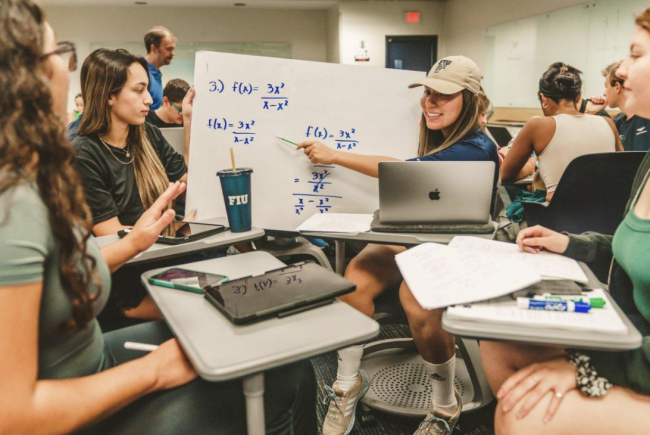You have /5 articles left.
Sign up for a free account or log in.

Modeling Practices in Calculus is a new curriculum and pedagogy and the intervention at the heart of a promising new study from researchers at Florida International University.
Florida International University
Calculus is historically a gatekeeper course for science, engineering, technology and math fields: if a student fails calculus, it’s do-not-pass go. Even non-STEM majors who enroll in calculus face its notoriously high DFW (D grade, failure and withdrawal) rate—50 percent by some estimates.
Does calculus have to be this way? STEM teaching reformers have been asking that question for some time. And a new study from Florida International University’s STEM Transformation Institute is more evidence that the answer is no.
“Students can and should pass calculus if enrolled in an MPC class,” says lead author Laird Kramer, professor of physics at FIU and founding director of the institute.
About MPC: Modeling Practices in Calculus is a new calculus curriculum and pedagogy and the intervention at the heart of Kramer’s paper. Instead of primarily watching a professor teach calculus (the “sage on a stage” model of instruction), students work in groups on carefully designed activities to “discover” calculus together (with the professor as “guide on the side”).
MPC, which builds on an existing model of calculus instruction called Student-Centered Active Learning Environments with Upside-down Pedagogies (SCALE-UP), aims to develop mathematical habits of mind. Students learn to identify patterns, form hypotheses and test them, make connections, and communicate ideas precisely.
Access to MPC has thus far been limited to instructors, FIU and non-FIU alike, who complete a two-day training through the STEM Transformation Institute. That’s because Kramer and his colleagues don’t want instructors to be using the curricular materials without the accompanying pedagogical strategies, as the two go hand in hand. But Kramer says the work has generated enough interest that he and colleagues launched a website with information on MPC.
Measuring learning gains: For their study, Kramer and colleagues randomly allocated 811 students across 32 calculus course sections and 19 instructors, over three semesters, to compare how and what students learned in courses using MPC (the treatment group) versus traditional, lecture-based instruction (the control group). Treatment groups included undergraduate peer learning assistants trained to facilitate student learning and promote culturally responsive instruction.
Students’ learning was assessed via questions that Kramer and his team embedded in end-of-term exams across the course sections. The effect size for learning gains in the treatment group was nearly 0.8, which is generally considered large. While effect sizes can be hard to parse, Kramer explains his like this: “If a clinical trial had the same effect size as we measured, they would stop control for lack of effect, since the treatment is so much better.” Hence the Science study’s clinically inspired title: “Establishing a New Standard of Care for Calculus Using Trials With Randomized Student Allocation.”
While course grades aren’t perfect (or always valid) indicators of student learning, students in the MPC treatment group had improved course grades—about 0.4 points higher on a 4.0 scale. This translates to success rates—meaning A, B or C grades—averaging 11 percent higher in MPC sections compared with traditional sections. The MPC sections also had lower course late-drop rates. These findings were consistent across student demographics.
The 19 professors who taught sections for the study included some with active learning experience and some new to it, though Kramer says all were prepared through summer and ongoing professional development.
Calculus and student success: Kramer says that with evidence-based active learning strategies like MPC, more students “can embrace calculus and use it as a launchpad for their STEM career, not fear it. It doesn’t need to be a barrier, even for historically underrepresented students.”
Elizabeth Béjar, FIU provost, says, “One of the variables of student success is if you actually improve the quality of teaching, you will be able to positively impact the quality of learning.”
FIU has increased its four-year graduation rates significantly over a decade and by 10 percent last year alone. Béjar says that promoting evidence-based teaching practices within specific disciplines has been one piece of the puzzle (data-based interventions are another).
“If you don’t have to repeat calculus or if you don’t have to repeat a chemistry class, because you were successful the first time, right, your time to degree is reduced.”
Béjar adds that evidence-based teaching isn’t just about time to degree or even calculus, however.
“It carries over. You’re really impacting the student’s ability to learn how they learn and to learn in more effective ways.”
How are you transforming instruction at your institution? Tell us here.





